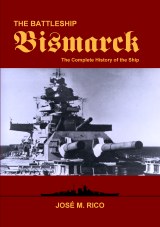 |
| Home Intro Technical History Crew Models Gallery Kriegsmarine Archives More Forum Español |
This article was first published in 1942 as the first Chapter of: “COASTAL COMMAND. The Air Ministry Account of the Part Played by Coastal Command in the Battle of the Seas. 1939 - 1942”.
Issued for the British Air Ministry by the Ministry of Information. Printed by the Whitefriars Press, LTD., London and Tonbridge S.O. CODE NO. 70-411*
“I GIVE YOU the hunter’s toast: ‘Good hunting and a good bag.’” With these words Admiral Lütjens ended his speech to the ship’s company of the “Bismarck.” They were heard throughout the vessel, those who could not be on deck listening to them through the loudspeakers situated in various parts of the battleship. The hour was a few minutes past noon on Monday, 19th May, 1941. That evening the “Bismarck” weighted anchor and put to sea, taking a Northerly course from Kiel Bay. It was the intention of Admiral Lütjens to raid commerce in the Atlantic. He had done so before earlier in the year, flying his flag in the “Gneisenau,” which together with the “Scharnhorst” had sunk twenty-two British and Allied ships, including the “Jervis Bay.” The “Gneisenau” and “Scharnhorst” were now in Brest and had already suffered damage from the attacks made on them by aircraft of Bomber and Coastal Commands. If Germany was to obtain a decision in the Battle of the Atlantic, other units of her Navy must be sent to sea. The “Bismarck” and the “Prinz Eugen” were chosen.
For the “Bismarck” it was her first and last voyage. She formed the main unit of the squadron made up of the eight-inch cruiser the “Prinz Eugen,” two destroyers and two mine-bumpers. After passing through the Great Belt the squadron moved up the conquered coast of Norway, and on the morning of 21st May entered a fjord near Bergen, where it anchored. There had been little sleep on board during that night, for an air-raid alarm had kept the crews at action stations until half-past eight in the morning. There was another alarm in the early afternoon which lasted a quarter of an hour. A little before dusk the Squadron put to sea again.
That day an aircraft of Coastal Command, in the course of a reconnaissance of the Norwegian coast, had flown as far North as Bergen. Reconnoitring that approaches to that port, the pilot discovered two warships, one of large size, at anchor in a small fjord.
On his return he made a cautious report of what he had seen to one of the Station Intelligence Officers. While they were talking the wet prints of the photographs which the pilot had taken were brought in. The Intelligence Officer examined them and saw that what the pilot surmised was indeed the truth. He spoke immediately with Headquarters, Coastal Command. “Bring me those prints at once,” ordered the Commander-in-Chief.
A slight difficulty arose. The only aircraft available to take them to Headquarters was that of the pilot who had just finished the patrol. Moreover, it was now evening. Nevertheless, he took off and flew South until with night fallen he found himself short of petrol on the outskirts of Nottingham, his home town. Here he landed and roused a friend of his, the owner of a garage and of a motor-car. They continued the journey together, driving through the night and the blackout at an average speed of fifty-two miles an hour. The prints were delivered at Coastal Command Headquarters in the early hours of the morning. Admiralty and photographic experts confirmed the opinion of the Intelligence Officer in Scotland. The “Bismarck” and the “Prinz Eugen” were out.
Very early that same morning they were attacked by six Whitleys and six Lockheed-Hudsons of Coastal Command. The attack was unsuccessful, for the weather was very thick and only two of the aircraft succeeded in reaching the fjord, where they dropped their load of armour-piercing bombs with no observed effect. Throughout that day –it was 22nd May- the weather could justifiably be described as atrocious. Nevertheless, reconnaissance of the Norwegian coast was maintained from first light until dark, every available aircraft of Coastal Command on the east coast of Scotland and the coast of Yorkshire being pressed into service. They flew at times through a full gale, at times through dense haze and cloud extending downwards to sea-level. Hour after hour they plunged into the mist shrouding Bergen harbour and the nearby fjords. It was in vain. No ships were seen. One of the pilots expressed the opinion that the enemy was no longer there because “I collided with nothing though I flew over the harbour at sea-level.”
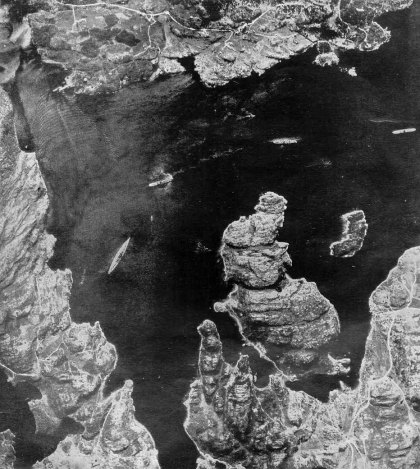
The picture that sank a battleship. The “Bismarck” caught by photographic reconnaissance in Dobric Fjord,
just before weighted anchor for her first and last sortie.
[This photograph is orientated upside (north) down,
and shows the Bismarck anchored in the Grimstadfjord with three merchant ships.]
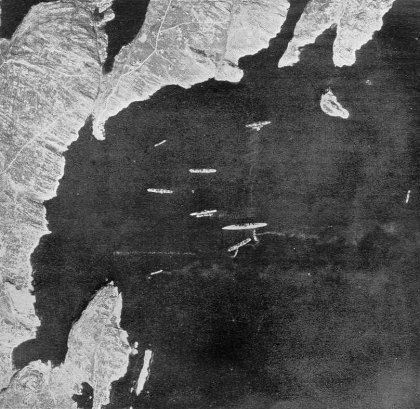
The “Prinz Eugen,” spotted in Hjelte Fjord, ready for a commerce-raiding voyage with the “Bismarck” in the Atlantic.
[This is Kalvanes Bay.]
The truth of this conjecture was proved about 6.30 that evening when the clouds above Bergen lifted for a moment –long enough for a shore-based naval aircraft, a Maryland, to report that a clear view had been obtained and that no warships had been seen. This aircraft was manned by very experienced officers of the Fleet air Arm, who carried out the flight successfully in spite of very bad weather and obtained information of the highest importance. Through that long day the “Bismarck” and the “Prinz Eugen” had, in fact, been steaming steadily Northwards, having parted company with their destroyers in the small hours. At 1.0 a.m. on 23rd May the enemy altered course to pass through the Denmark Strait between Iceland and Greenland. By this time they were fully aware that they had been seen, but they judged that to follow this route would offer the best chance to elude the British Fleet now steaming to intercept them.
The weather on 23rd May was still very bad –too bad to patrol the Norwegian coast. Sunderland flying boats and Hudsons were able to cover the passages between Iceland and the Faroes and between the Faroes and the Shetlands. The Sunderlands maintained their patrol in relays from a quarter past six in the morning to a quarter part nine in the evening, the Hudsons from 4.0 a.m. to 5.15 p.m. The Sunderlands covered more than two thousand miles in a single sortie; but the weather was against them. They encountered strong head winds, fog, rain-squalls, and heavy cloud in which severe icing conditions developed. In addition to the Sunderlands, two Catalina flying boats covered the Iceland Channel, beginning their patrol at 1.0. p.m. They had to abandon their task when unbroken cloud down to three hundred feet accompanied by unceasing rain reduced visibility to less than a thousand yards.
That evening H.M.S. “Suffolk” sighted the German warships in the Denmark Strait and soon afterwards a Sunderland and a Hudson from Iceland set off in the long twilight of those far Northern latitudes to search for the enemy. The Hudson could not find them and returned. The Sunderland held on. In the meantime the “Bismarck” and the “Prinz Eugen” had also been seen by H.M.S. “Norfolk.” Matters stood thus at the end of 23rd May. The two cruisers shadowed the enemy throughout the night.
Next morning another Hudson took off and at 5.54 a.m. sighted the “Bismarck” and the “Prinz Eugen” engaged in combat with the “Hood” and the “Prince of Wales.” Low clouds made it impossible to identify the opposing forces with certainty, but it could be perceived that one of the ships had suffered two direct hits, of which the second was followed by and explosion.
Meanwhile the Sunderland [Z/201] from Iceland had arrived in the neighbourhood of the “Suffolk,” and, on sighting this ship, saw at the same time the flash of gunfire well ahead. “As we closed,” says the captain [Flight Lieutenant R.J. Vaughn] in his report, “two columns, each of two ships in line ahead, were seen to be steering on parallel courses at an estimated range of twelve miles between the columns. Heavy gunfire was being exchanged and the leading ship of the port column was on fire in two places, on fire being at the base or the bridge superstructure and the other farther aft. In Spite of these large conflagrations she appeared to be firing at least one turret forward and one aft.” At first the captain of the Sunderland could not identify the burning ship. He turned towards the starboard column and noticed that the second of the two ships composing it was making a considerable amount of smoke, and that oil escaping from her was leaving a broad track upon the surface of the sea. He approached nearer, and as he did so the ship on fire in the column to port blew up.
A few seconds later the Sunderland came under heavy A.A. fire at the moment when its captain was identifying the ships in the starboard column as the “Bismarck” and the “Prinz Eugen.” He was forced to take immediate cloud cover and when, five minutes later, he emerged into an open patch, the ship which had blown up, and which he now realised was British, though he did not learn until a little later that she was the “Hood,” had almost completely disappeared. “Only part of the bows was showing.” This sank almost at once, and when the Sunderland flew over the spot all that could be seen was an empty raft, painted red, surrounded by wreckage in the midst of a large patch of oil.
Watching the remainder of the action, the captain of the Sunderland saw the “Prince of Wales” turn away under cover of a “light smoke screen” and open the range to about fifteen miles. The Sunderland closed the “Bismarck” to make quite certain of her identity and then, returning to the neighbourhood of the “Suffolk”, exchanged visual signals with her and learnt that the ship which had been sunk was the “Hood.” It was then about a quarter past seven on the morning of 24th May.
Throughout that day the shadowing of the German ships by the Royal Navy continued. A Catalina of the Coastal Command saw them at 12.32 p.m. and, remaining in contact for two hours, at intervals signalled their course and speed to the pursuers. Coming under anti-aircraft fire, the flying boat developed engine trouble which forced it to return to base. This was the last contact with the enemy made by Coastal Command that day. The “Norfolk” and “Suffolk” with the “Prince of Wales” held on. The “King George V,” in which the Commander-in-Chief of the Home Fleet was flying his flag, and the aircraft carrier “Victorious” were now rapidly approaching.
On board the “Bismarck” there was much rejoicing, not without good reason. She had damaged the “Prince of Wales.” She had sunk the “Hood.” That evening there was a large extra issue of sausage, chocolate and cigarettes, and Hitler conferred the Knight Insignia of the Iron Cross on the First Gunnery Officer. True, the speed of the ship had been reduced, for a shell from the “Hood” had partially flooded some of her compartments and had also made it impossible to use the oil fuel in the forward bunkers –it was this oil escaping from the ship which had left the broad stain upon the sea seen by the Sunderland- but a formidable unit of the British Fleet had been disposed of and another, still more formidable, had been damaged. Surely it was now time to return to the safety of the Norwegian Fjords!
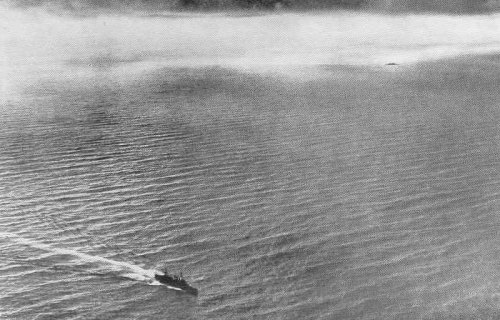
“Good hunting” was the German admiral’s message to his men. But the hunter became the hunted. A County Class cruiser,
with the H.M.S. “Prince of Wales” in the distance, is chasing the “Bismarck.”
Captain Lindemann, in command of the “Bismarck,” thought so; but he was overruled by his Admiral, who ordered the “Prinz Eugen” to part company while the “Bismarck” held on her course for a French port. Night fell without further incident, but soon after midnight torpedo-carrying Swordfish from the “Victorious,” supported by Fulmars, delivered an attack in which a hit was scored on the starboard side. Survivors from the “Bismarck” subsequently spoke with surprise and admiration of the courage displayed by the British pilots. One Swordfish, they said, after being hit, still tried to get into a position from which to release its torpedo before plunging into the sea. The anti-aircraft fire of the “Bismarck” was tremendous, many of the guns becoming red-hot. Our losses in this attack were two Swordfish and two Fulmars, the crew of the Fulmars being saved.1) It was put about on board the “Bismarck” that forty-seven British aircraft had been destroyed.
Soon after 3 o’clock that morning, 25th May, visibility became very bad, and contact with the “Bismarck” was at last lost by the cruisers “Norfolk” and “Suffolk”, which had shadowed her so tenaciously since sunset on 23rd May. When last seen her speed had been reduced to 20 knots. It now seemed to the Admiralty that, in view of the damage which she had sustained and her heavy consumption of fuel, she would either double back on her track and return to Norway or make for one of the French ports in order to refuel and refit. Coastal Command did its best to meet both contingencies.
All that afternoon and throughout the night three Catalinas searched the area through which it was considered most probable that the “Bismarck” was steaming. They remained air-borne for 19 hours 36 minutes, 20 hours 54 minutes, and 22 hours and 21 minutes respectively. They saw nothing of the enemy, though one of them passed over a warship in the dead of night and was not able to identify it, low cloud making the use of parachute flares impossible.
During 26th May Hudson patrolled the Denmark Strait all day in very bad weather, while Sunderlands, with the help of a Catalina and a Hudson, covered the passage between Iceland and Faroes. None of these aircraft sighted the enemy. Units of the Royal Navy were taking up fresh dispositions. The main body of the Home Fleet was steaming at high speed in a South-Westerly direction from Northern waters. Another force, headed by the “Renown,” was steaming North-Westwards at high speed from Gibraltar, while the “Rodney” and the “Ramillies,” on escort duty in the North Atlantic, proceeded to move in the direction of the enemy.
On board the “Bismarck” the mood of exaltation occasioned by her victory over the “Hood” began to give way to one of anxiety which increased to alarm when, shortly before midday, Admiral Lütjens informed the crew that it had proved impossible to shake off pursuit and that, though aircraft and U-boats would be forthcoming as soon as the ship came within their range, an action would almost certainly have to be fought, in which case the best which could be hoped for would be that the “Bismarck” would take some of the British Navy to the bottom with her. Yet, as the day wore on, and no aircraft appeared over them and no hostile ships were sighted, their spirits rose again, especially when at evening they entered a U-boat area.
Dawn on 26th May broke over a heavy sea above which scudded broken clouds. During the morning the weather became somewhat hazy. At 10.30 a Catalina flying boat [Z/209] appeared above the “Bismarck.” It had taken off from a base in Northern Ireland seven hours before and was one of two sent to patrol some five hundred miles out in the Atlantic almost due West of Land’s End. Contact with the “Bismarck” had been regained after a lapse of thirty-one and a half hours.
This had been achieved by brilliant calculation on the part of the Air and Naval Staffs, whose plotting of the “Bismarck’s” probable course was accurate enough to enable the Commander-in-Chief, Coastal Command, to design the pattern of his patrols so as to place them exactly where the enemy was most likely to be found. The sighting of the “Bismarck” at this stage was, in fact the second principal factor which ensured her destruction, the first being the reconnaissances which had found her near Bergen and then discovered that she had sailed.
“‘George*’ was flying the aircraft,” said the pilot [Dennis Briggs], “at five hundred feet when we saw a warship. I was in the second pilot’s seat when the occupant of the seat beside me, an American [US Navy Ensign Leonard “Tuck” Smith], said ‘What the devil’s that?’ I stared ahead and saw a dull black shape through the mist which curled above a very rough sea. ‘Looks like a battleship,’ he said. I said: ‘Better get closer. Go round its stern.’ I thought it might be the ‘Bismarck,’ because I could see no destroyers round the ship and I should have seen them had she been a British warship. I left my seat, went to the wireless operator’s table, grabbed a piece of paper and began to write out a signal. The second pilot had taken over from ‘George’ and gone up to 1,500 feet into broken cloud. As we came round he must have slightly misjudged his position, for instead of coming up astern we found ourselves right over the ship in an open space between the clouds. The first thing I knew about this was when two black puffs appeared outside the starboard side wing tip. In a moment we were surrounded by black puffs. Stuff began to rattle against the hull. Some of it went through and a lot more made dents in it. I scribbled ‘End of message’ and handed it to the wireless operator. In between the smudges of the bursting shells I looked down on the ship which seemed to me to be one big, winking flame. She was taking violent avoiding action by turning hard to starboard, heeling well over.”
The Catalina took similar action to dodge the A.A. fire. None of the crew was hit, though a piece of shell passed upwards through the floor between the two pilots as they were changing places. The only casualties occurred in the galley, where one of the crew, who was washing up the breakfast things, “dropped two china R.A.F. plates and broke them.”
Touch with the “Bismarck” was temporarily lost, for the evasive action taken by the Catalina had removed her some miles from the ship. At 11.15 aircraft from “Ark Royal,” now about 70 miles away, found her again, and another Coastal Command Catalina in the neighbourhood was diverted from its patrol area and reported sighting the enemy at 1.28 p.m. It kept the “Bismarck” more or less in view during the afternoon, though it lost her at intervals owing to the bad visibility. It had to return to base at 6 p.m.
Some three hours later an event occurred which was the final factor in accomplishing the fate of the “Bismarck.” As will have been realised, she had been shadowed on and off by aircraft of Coastal Command or by naval aircraft throughout the day of 26th May. Three powerful forces of the Royal Navy were closing in upon her. At five minutes to nine in the evening, 15 Swordfish torpedo-carrying aircraft from the “Ark Royal” launched an attack. It lasted half an hour, and when it was over the “Bismarck’s” steering gear was wrecked and her rudders jammed at an angle of between 10 and 15 degrees, thus causing her to turn in circles. Throughout that fierce half-hour she put up tremendous A.A. barrage, firing off practically all her A.A. ammunition. The Swordfish “darted through it like flashed of lighting” to score two and possibly three hits. No aircraft was lost, the only casualties being a pilot and an air gunner who were wounded.
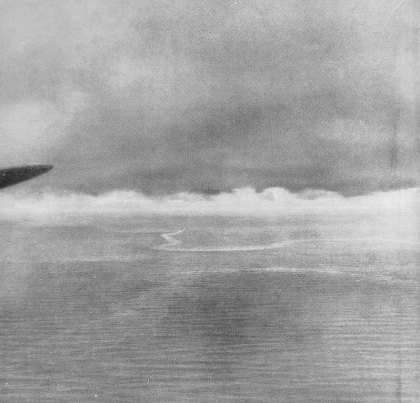
The tell-tale wake of the “Bismarck”, showing that the attack by Swordfish aircraft has damaged her steering-gear
and left her out of control.
The position of the “Bismarck” was now desperate. Despite all their efforts her divers, who were promised the Knight Insignia of the Iron Cross if they succeeded, could only free one rudder. The other remained jammed and immovable. That night destroyers, of which on was the “Cossack,” went in close and delivered six torpedo attacks, scoring three more hits.2) Dawn on the 27th May found the “Bismarck” striving to make about ten knots. By now the main British force had come up, and at 8.45 a.m. the great ships opened fire. In less than an hour the “Bismarck” was a blazing wreck; but she did not surrender. The coup the grâce was given by the torpedoes of the “Dorsetshire,” and the “Bismarck” sank shortly afterwards with her colours flying.
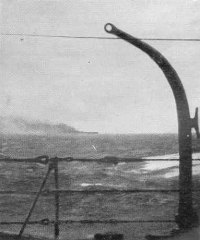
The Kill, A battered, blazing hulk after many hits by gunfire,
the “Bismarck” is sinking.
Throughout the 27th and 28th May Hudsons of Coastal Command were busy escorting units of the Fleet moving back to their bases after the action. A number of combats, mostly with Heinkels, took place. During one of them, the British and German aircraft found themselves, after a spirited engagement over the sea, flying up a valley in Northern Ireland below the level of the hill-tops. Luck was with the enemy. A round of tracer ammunition became jammed in the breech of the Hudson’s port forward gun, where it exploded, filling the cockpit with smoke. When the pilot could see clearly again the Heinkel had got away in the gathering darkness.
In another, the port gunner, whose gun had been knocked out of his hand, got it into action again, silenced a Heinkel’s fire and forced its pilot to jettison the bombs. In a third, the Hudson’s pilot, a Wing Commander, having used all the ammunition of his front guns, took up position almost underneath the Heinkel with which he was engaged, and “by suddenly throttling back for an instant put his aircraft in a position from which the rear guns could be brought to bear. Only fifty yards then separated the two aircraft, and the rear gunner used his guns almost at point-black range, spraying the Heinkel along its whole length until the port engine caught fire. Into that fire he poured everything he had got. The Heinkel burst into flames and crashed into the sea.”
Soon after the “Bismarck” sank a message was received by the Commander-in-Chief of Coastal Command. “The Admiralty,” it read, “wish gratefully to acknowledge the part played by the reconnaissance of the forces under your command, which contributed in a large measure to the successful outcome of the recent operation.”
The story of the hunting and destruction of the “Bismarck” has been told at some length because it illustrates no only an important function of Coastal Command but also its close co-operation with the Royal Navy. On this, as on many other occasions, their combined efforts have discomfited the Germans. As Chaucer said of the doctor and the apothecary: “Each of hem made other for to winne.” Together they seek out the enemy on the high seas to destroy him. Together they are striving to keep free the great ocean routes along which steam in convoy ships freighted with the commodities necessary for the successful prosecution of the war. Together they are denying such routes to the enemy by the maintenance of a strict and pitiless blockade.
These tasks the Royal Navy has performed in time of war for upwards of a thousand years, Coastal Command for scarcely a thousand days. Buy if the weapons it uses are something new in the history of the world, if the craft it means traverse the fields of air rather than the fields of ocean, the object it intends to achieve is the same. It can be summed up in nice words: Find the enemy; strike the enemy; protect our ships. How Coastal Command performs this triple task it is the aim of this account to show.
1) Actually none of the obsolete Swordfish were shot down.
2) The destroyers did not obtain any hits on “Bismarck” that night.
* ‘George’ is the nickname given by the Royal Air Force to the automatic pilot.

| Home Guestbook Quiz Glossary Help us Weights & Measures Video Credits Links Contact |
